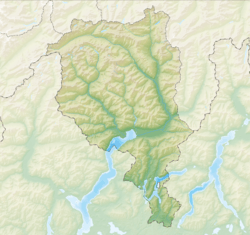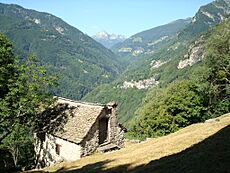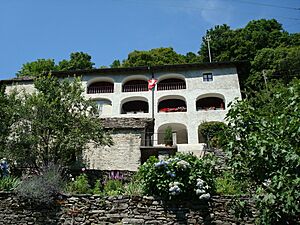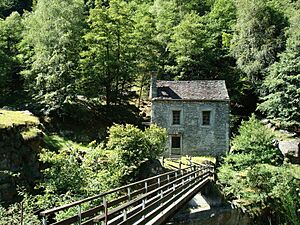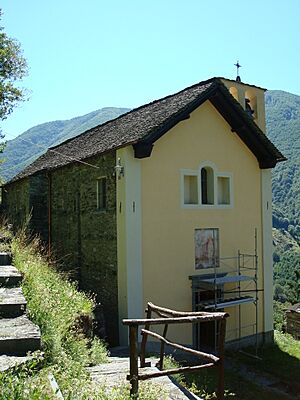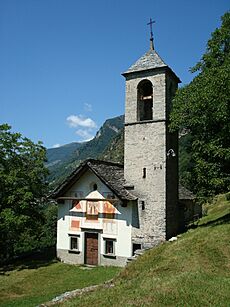Mosogno facts for kids
Quick facts for kids
Mosogno
|
||
|---|---|---|
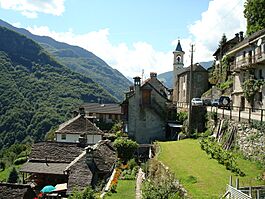
Mosogno village
|
||
|
||
| Country | Switzerland | |
| Canton | Ticino | |
| District | Locarno | |
| Area | ||
| • Total | 8.61 km2 (3.32 sq mi) | |
| Elevation | 781 m (2,562 ft) | |
| Population
(December 2004)
|
||
| • Total | 62 | |
| • Density | 7.20/km2 (18.65/sq mi) | |
| Postal code |
6611
|
|
| Surrounded by | Borgnone, Intragna, Isorno, Onsernone | |
Mosogno was once a municipality (a type of local government area) in the Locarno district. It is located in the canton of Ticino in Switzerland. On April 10, 2016, Mosogno joined with other nearby villages. These were Vergeletto, Gresso, and Isorno. They all became part of the larger municipality of Onsernone.
Contents
Discovering Mosogno's Past
Mosogno was first mentioned in old writings in 1277. Back then, it was called Mosogno. Later, in 1352, it was known as Muxognio.
During the Middle Ages, Mosogno was one of five "squadrons." These squadrons together formed the larger community of Onsernone. In 1803, Mosogno became its own independent municipality.
The church of S. Bernardo was built in 1596. It became a parish church in 1685. This meant it was the main church for its own area, separate from the church in Loco.
Other small chapels were also built. The chapel of St. Maria Addolorata in Mosogno Sotto dates back to 1684. In Bairon, the chapel of S. Maria della Natività was built in 1657. The chapel of S. Giacomo in Chiosso was built in the late 1600s.
Over time, fewer people lived in Mosogno. This happened because a straw factory closed down. Also, many people moved away to bigger cities.
Exploring Mosogno's Geography
Mosogno covers an area of about 8.61 square kilometers (3.32 square miles). Most of this land, about 86.5%, is covered by forests.
A small part, less than 1%, is used for farming. About 0.7% of the land has buildings or roads. Rivers and lakes make up about 2.4% of the area. The remaining 8.1% is land that cannot be used for farming or building. This includes rocky areas and places with wild plants.
Mosogno village is located in the Locarno district. It sits at an elevation of about 783 meters (2,569 feet). It is along the main road through the Onsernone valley. Besides the main village, Mosogno also includes smaller areas called hamlets. These are Bairone, Chiosso, and Mosogno Sotto.
Who Lives in Mosogno?
In 2014, Mosogno had a population of 51 people. Over the years, the number of people living in Mosogno has slowly decreased.
Most people in Mosogno speak Italian. This is the main language in the Ticino canton. A smaller number of people speak German. A very small number speak Spanish.
Here is how the population of Mosogno has changed over time:
| year | population |
|---|---|
| 1795 | 290 |
| 1808 | 284 |
| 1836 | 319 |
| 1850 | 307 |
| 1870 | 365 |
| 1950 | 141 |
| 1960 | 73 |
| 2000 | 57 |
Discovering Mosogno's Sights
The entire village of Mosogno Sotto is a special place. It is listed as part of the Inventory of Swiss Heritage Sites. This means it is important for its history and beauty.
Mosogno's Economy and Work
In 2005, a few people worked in Mosogno. Some worked in the primary economic sector, like farming. Others worked in the secondary sector, which includes making things. A few people worked in the tertiary sector, which means providing services.
Many people who live in Mosogno travel to other places for work. Some use public transportation, while others drive their own cars.
Religion in Mosogno
Most people in Mosogno are Roman Catholic. A smaller number belong to the Swiss Reformed Church. Some people follow other religions, and a few did not state their religion.
Mosogno's Weather Patterns
Mosogno gets a lot of rain or snow each year. On average, it has about 105 days of precipitation. The total amount of rain and snow is about 2032 millimeters (80 inches) per year.
September is usually the wettest month. May has the most days with rain or snow. December is the driest month of the year.
Learning and Education in Mosogno
Many adults in Mosogno have completed higher education. This means they have gone to a university or a special college.
In 2009, there were a few students in Mosogno. The education system in Ticino offers kindergarten for young children. After that, students go to primary school for five years. Then, they move on to middle school or a program to prepare for higher education.
Some students from Mosogno attend schools in other municipalities.
Images for kids
See also
 In Spanish: Mosogno para niños
In Spanish: Mosogno para niños




